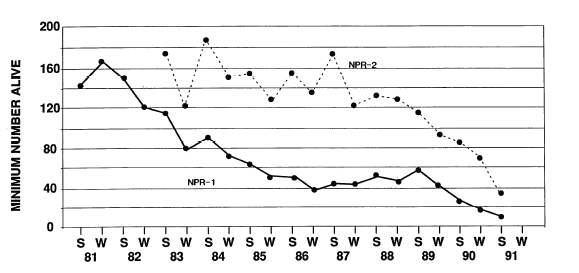San Joaquin Kit Fox (Vulpes macrotis mutica)
 Description & Ecology
Description & Ecology
 |
| San Joaquin kit fox: defenders.org |
The San Joaquin Kit Fox is native to the grasslands, scrub lands, and wetlands of the Central Valley in California. They are part of the Canidae family. Kit foxes are the smallest canid species in North America, but San Joaquin kit foxes are the largest subspecies in size. With large ears, narrow noses, slim bodies, long bushy tails, and long legs, San Joaquin kit fox males can average about 5 pounds (2kg) and are about 32 inches. Females are smaller on average. Their coats vary from a tan color in the summer to a silver-grey color in the winter. Kit foxes are nocturnal and live in dens during the year for shelter which provides warmth during the winter and to cool off during the summer. They may build their own dens, but they also will modify existing burrows constructed by other animals. They consume small mammals (i.e mice, squirrels, rabbits, ground-nesting birds, insects) and their predators include: red foxes, coyotes, domestic dogs, bobcats, and large raptors. They typically do not have the need to drink water because their prey provides enough liquid for them to live. They birth about 2 – 6 pups in February or March, and the pups emerge from the den when they are about a month old. They are capable to breed at one year of age. The average lifespan of a kit fox is approximately 5.5 years.
 Geographic & Population Changes
(Date/Type of Listing)
Geographic & Population Changes
(Date/Type of Listing)
 |
| Figure 1. Population distribution. |
The San Joaquin kit fox was declared as endangered on 3/11/1967 in the California/Nevada Region or wherever found. The San Joaquin kit fox’s range was extensive before 1930. It inhabited much of the west side of California’s San Joaquin Valley (see Figure 1). Today, the largest populations are located near western Kern county, Elk Hills, and the Carrizo Plain Natural Area in San Luis Obispo County. The land that they once inhabited has become extremely fragmented due to human activity, and many have been forced to the edges of San Joaquin Valley and in the surrounding areas of the coastal ranges in Sierra Nevada. It is believed that since 1930, the kit fox range has been reduced to more than half the original range. Because of habitat reduction, there are fewer than 7,000 San Joaquin kit foxes left in the area.
 Cause of Listing & Main Threats
Cause of Listing & Main Threats
 |
| Figure 2. Undeveloped areas of San Joaquin Valley. |
 |
| Figure 3. San Joaquin kit fox population. |
Much of the area has been lost and degraded due to oil overexploitation, development of agricultural practices leading to land extensive land conversions (i.e livestock grazing, wind turbines, crops, vineyards, orchards, irrigated pastures), and irregular precipitation patterns due to climate change. By 1979, it was estimated that only 6.7% of San Joaquin Valley remained undeveloped. They are also threatened by the pesticides expelled in the areas of intensive agricultural use, industrial projects, and residential areas. All these factors have constricted the San Joaquin kit foxes into fragmented habitats, which are not only reduced in size, but also quality. These habitats are not the optimum for San Joaquin kit fox survival, and the alarming decline in population has caused them to be on the endangered species list amongst many other species.
 Description of Recovery Plan
Description of Recovery Plan
 |
| San Joaquin kit fox pups. Photo: defenders.org |
The US Fish & Wildlife service developed a Recovery Plan for the San Joaquin kit fox in 1998. Its aim is to implement a recovery plan for the San Joaquin kit fox to promote long term conservation and permanent recovery of the endangered species. To protect kit fox habitats, the recovery plan seeks to expand existing natural land by resorting retired farmland in the agricultural parts of California. It also aims to enhance habitat and maintain movement corridors to promote genetic diversity among the different populations of kit foxes. The recovery plan also outlines the process to determine the current geographic distributions of kit foxes to seek out potential habitat in the expanded areas. In addition to determining the current distribution, the recovery plan also intends to establish a population monitoring program to conduct further research about population movements, genetic features of different populations, and interactions with other species that share the same habitats. Because data on San Joaquin kit foxes are limited, the primary focus of the recovery plan is to protect the existing land and collect data about the San Joaquin kit fox in order to help find the most effective conservation methods to protect the population.
 What can you do?
What can you do?
There are several ways you can do your part in protecting these cute animals:
Don’t feed kit foxes: despite their similar appearance to domestic dogs, they have a complete different diet.
Don’t fill or destroy any burrows you find: these burrows may be home to kit foxes and their pups.
Put away any sports nets used for recreational reasons: kit foxes often are estranged in nets that are left out during the night.
Avoid using any traps or rodent poisons in kit fox habitats: these are harmful and fatal to kit foxes who often get injured from traps and consuming rodent poison.
Other Resources:
References:
"Basic Facts about San Joaquin Kit Foxes." Defenders of Wildlife. Defenders of Wildlife, n.d. Web. 5 Nov. 2017.
Brown, N.L, C.D Johnson, P.A Kelly, and D.F Williams. "San Joaquin Kit Fox - Vulpes Macrotis Mutica." Endangered Species Recovery Program. CSU Stanislaus, Endangered Species Recovery Program, n.d. Web.
Endangered Species Facts (2010): n. pag. Endangered Species Facts. U.S Environmental Protection Agency, Feb. 2010. Web.
“Keep Me Wild: Kit Fox." California Department of Fish and & Wildlife. Office of Communications, Education and Outreach, n.d. Web.
“Saving the San Joaquin Kit Fox." Center for Biological Diversity. Center for Biological Diversity, n.d. Web.
“San Joaquin Kit Fox: Vulpes Macrotis Mutica." Sacramento Fish & Wildlife Office. U.S Fish & Wildlife Service, 16 Sept. 2016. Web.








You did great job at presenting your blog and talking about every topic in depth. It is cool to know that the largest populations of this specie are located right here in San Luis Obispo, but also sad to learn that their range has been cut in half since 1930. Also, your blog helped me gain a better awareness for the destruction developing agriculture and oil overexploitation causes to species. After reading this blog it has made me want to help protect this specie more and helped me gain knowledge on how to. Good work!
ReplyDelete-Beau Zacharia
Your facts in the Kit Fox were super interesting! I had no idea that they could live without water, or that their biggest population is where we live! I think your blog was really well laid out and it made reading it super easy and entertaining (as well as informational). I think this recovery plan is particularly interesting because while some focus on adopting the animal or donating money, this one really focuses on directly helping the animal recover its natural environment.
ReplyDeleteLena Vogler
Awesome job! I really enjoyed all of the visuals you provided! Its very sad to see that they have such a short life span. Hopefully this species will be able to make the recovery! Overall, great work!
ReplyDelete-Jackson Werbelow
The kit fox is so adorable I want to own one! I'm surprised that they only way roughly 5 pounds, but it's sad that they have such a short lifespan. You're blog was very nicely organized and kept it easy to follow, and you had some great facts to add in that I wouldn't have known at all! Overall, you did a really great job.
ReplyDelete- Natalie Weis